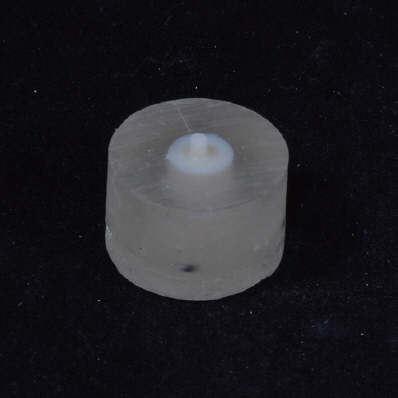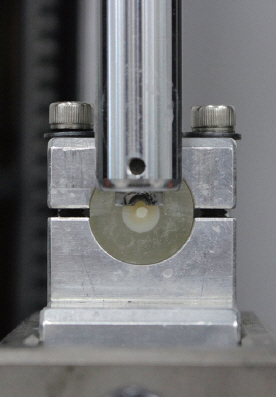J Dent Rehabil Appl Sci.
2018 Jun;34(2):89-96. 10.14368/jdras.2018.34.2.89.
Effect of delayed time, surface treatment, and repair material on shear bond strength of repaired bis-acryl composite resin
- Affiliations
-
- 1Department of Prosthodontics, College of Dentistry, Wonkwang University, Iksan, Republic of Korea. cash78@empas.com
- KMID: 2422650
- DOI: http://doi.org/10.14368/jdras.2018.34.2.89
Abstract
- PURPOSE
The aim of this study was to evaluate the effect of delayed time, surface treatment, and repair materials on repair of bisacryl composite resin through comparison of shear bond strength and to evaluate the utility of bis-acryl composite resin repair using polymethyl methacrylate resin.
MATERIALS AND METHODS
A total of 90 bis-acryl composite resin specimens were fabricated and classified into 9 test groups, each of 10 pieces according to delayed time, surface treatment and repair material. The shear bond strength of each specimen was measured using a universal testing machine immediately after fabrication and analyzed using a statistical analysis program (IBM SPSS statistics 20). After the shear bond strength measurement, the fracture surface of the specimen was observed.
RESULTS
The highest shear bond strength (17.54 ± 3.14 MPa) was observed in the experimental group bonded immediately with a light-curing flowable composite resin using a bonding agent.
CONCLUSION
When repairing bis-acryl composite resin, it is necessary to consider whether to remake according to the delayed time. For effective repair, it is desirable to consider appropriate materials and surface treatment methods according to the site or purpose of use.
Keyword
Figure
Reference
-
References
1. Patras M, Naka O, Doukoudakis S, Pissiotis A. Management of provisional restorations'deficiencies:a literature review. J Esthet Restor Dent. 2012; 24:26–38. DOI: 10.1111/j.1708-8240.2011.00467.x. PMID: 22296692.2. Michalakis K, Pissiotis A, Hirayama H, Kang K, Kafantaris N. Comparison of temperature increase in the pulp chamber during the polymerization of materials used for the direct fabrication of provisional restorations. J Prosthet Dent. 2006; 96:418–23. DOI: 10.1016/j.prosdent.2006.10.005. PMID: 17174659.3. Young HM, Smith CT, Morton D. Comparative in vitro evaluation of two provisional restorative materials. J Prosthet Dent. 2001; 85:129–32. DOI: 10.1067/mpr.2001.112797. PMID: 11208201.4. Schwantz JK, Oliveira-Ogliari A, Meereis CT, Leal FB, Ogliari FA, Moraes RR. Characterization of bis-acryl composite resins for provisional restorations. Braz Dent J. 2017; 28:354–61. DOI: 10.1590/0103-6440201601418. PMID: 29297557.5. Hammond BD, Cooper JR 3rd, Lazarchik DA. Predictable repair of provisional restorations. J Esthet Restor Dent. 2009; 21:19–24. discussion 25. DOI: 10.1111/j.1708-8240.2008.00225.x. PMID: 19207453.6. Donovan TE, Hurst RG, Campagni WV. Physical properties of acrylic resin polymerized by four different techniques. J Prosthet Dent. 1985; 54:522–4. DOI: 10.1016/0022-3913(85)90425-1. PMID: 3862809.7. Chee WW, Donovan TE, Daftary F, Siu TM. Effect of chilled monomer on working time and transverse strength of three autopolymerizing acrylic resins. J rosthet Dent. 1988; 60:124–6. DOI: 10.2341/12-429-L. PMID: 24807815.8. Eliasson ST, Tibballs J, Dahl JE. Effect of different surface treatments and adhesives on repair bond strength of resin composites after one and 12 months of storage using an improved microtensile test method. Oper Dent. 2014; 39:206–16. DOI: 10.2341/12-429-L. PMID: 24807815.9. Staxrud F, Dahl JE. Role of bonding agents in the repair of composite resin restorations. Eur J Oral Sci. 2011; 119:316–22. DOI: 10.1111/j.1600-0722.2011.00833.x. PMID: 21726294.10. Shim JS, Lee JY, Choi YJ, Shin SW, Ryu JJ. Effect of light-curing, pressure, oxygen inhibition, and heat on shear bond strength between bis-acryl provisional restoration and bis-acryl repair materials. J Adv Prosthodont. 2015; 7:47–50. DOI: 10.4047/jap.2015.7.1.47. PMID: 25722837. PMCID: PMC4341186.11. Balkenhol M, Meyer M, Michel K, Ferger P, Wöstmann B. Effect of surface condition and storage time on the repairability of temporary crown and fixed partial denture materials. J Dent. 2008; 36:861–72. DOI: 10.1016/j.jdent.2008.06.006. PMID: 18691795.12. Ward JE, Moon PC, Levine RA, Behrendt CL. Effect of repair surface design, repair material, and processing method on the transverse strength of repaired acrylic denture resin. J Prosthet Dent. 1992; 67:815–20. DOI: 10.1016/0022-3913(92)90591-W. PMID: 1403868.13. Cavalcanti AN, De Lima AF, Peris AR, Mitsui FH, Marchi GM. Effect of surface treatments and bonding agents on the bond strength of repaired composites. J Esthet Restor Dent. 2007; 19:90–8. discussion 99. DOI: 10.1111/j.1708-8240.2007.00073.x. PMID: 17374114.14. Appleby DC. Repair of fractured connectors in a provisional fixed partial denture. J Prosthet Dent. 2001; 86:449–50. DOI: 10.1067/mpr.2001.118566. PMID: 11677546.15. Hagge MS, Lindemuth JS, Jones AG. Shear bond strength of bis-acryl composite provisional material repaired with flowable composite. J Esthet Restor Dent. 2002; 14:47–52. DOI: 10.1111/j.1708-8240.2002.tb00147.x. PMID: 11915395.16. Van Meerbeek B, Yoshihara K, Yoshida Y, Mine A, De Munck J, Van Landuyt KL. State of the art of self-etch adhesives. Dent Mater. 2011; 27:17–28. DOI: 10.1016/j.dental.2010.10.023. PMID: 21109301.17. Rathke A, Tymina Y, Haller B. Effect of different surface treatments on the composite-composite repair bond strength. Clin Oral Investig. 2009; 13:317–23. DOI: 10.1007/s00784-008-0228-2. PMID: 18839227.18. Wendler M, Belli R, Panzer R, Skibbe D, Petschelt A, Lohbauer U. Repair Bond Strength of Aged Resin Composite after Different Surface and Bonding Treatments. Materials (Basel). 2016; 9:E547. DOI: 10.3390/ma9070547. PMID: 28773669. PMCID: PMC5456933.19. Matinlinna JP, Lassila LV, Ozcan M, Yli-Urpo A, Vallittu PK. An introduction to silanes and their clinical applications in dentistry. Int J Prosthodont. 2004; 17:155–64. PMID: 15119865.20. Staxrud F, Dahl JE. Silanising agents promote resin-composite repair. Int Dent J. 2015; 65:311–5. DOI: 10.1111/idj.12188. PMID: 26453196.21. Burns DR, Beck DA, Nelson SK. Committee on Research in Fixed Prosthodontics of the Academy of Fixed Prosthodontics. A review of selected dental literature on contemporary provisional fixed prosthodontic treatment:report of the Committee on Research in Fixed Prosthodontics of the Academy of Fixed Prosthodontics. J Prosthet Dent. 2003; 90:474–97. DOI: 10.1016/S0022-3913(03)00259-2. PMID: 14586312.22. Chen HL, Lai YL, Chou IC, Hu CJ, Lee SY. Shear bond strength of provisional restoration materials repaired with light-cured resins. Oper Dent. 2008; 33:508–15. DOI: 10.2341/07-130. PMID: 18833857.
- Full Text Links
- Actions
-
Cited
- CITED
-
- Close
- Share
- Similar articles
-
- Bonding of conventional provisional resin to 3D printed resin: the role of surface treatments and type of repair resins
- Effect of light-curing, pressure, oxygen inhibition, and heat on shear bond strength between bis-acryl provisional restoration and bis-acryl repair materials
- A study on the shear bond strength between 3D printed resin and provisional resin after thermal cycling
- Chemical compatibility of interim material and bonding agent on shear bond strength
- The effect of different bonding systems on shear bond strength of repaired composite resin




